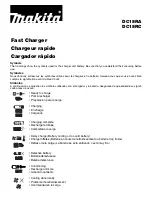
WARNINGS AND SAFETY NOTES
• Do not leave the charger unattended while charging. If any malfunction
occurs, TERMINATE THE PROCESS AT ONCE and refer to the operation
manual.
• Disconnect the battery if it becomes hot immediately. Allow the battery
to cool down before reconnecting.
• Do NOT attempt to charge incompatible types of rechargeable batteries
or even dry (alkaline, zinc-carbon) batteries. This charger is designed
to only charge and discharge Nickel-Cadmium, Nickel-Metal Hydride,
Lithium-Ion, Lithium-Polymer (regular and HV), LiFePO4, and Lead-Acid
batteries.
• Never attempt to charge or discharge the following types of batteries.
• A battery pack which consists of different types of cells (including
different manufacturers)
• Non-rechargeable batteries (Explosion hazard).
• Batteries that require a different charge technique from NiCd, NiMH,
LiPo, LiHV or Pb.
• A faulty or damaged battery.
• A battery fitted with an integral charge circuit or a protection circuit.
• Batteries installed in a device or which are electrically linked to other
components.
• Batteries that are not expressly stated by the manufacturer to be
suitable for the currents the charger delivers during the charge process.
• Keep the charger well away from dust, damp, rain, heat, direct sunshine
and vibration. Never drop it.
• Do not allow foreign objects into the charger.
• The allowable AC input voltage is 100-240 V/50-60 Hz or 10-30 V DC
voltage. DO NOT try to feed the charger simultaneously using the AC and
DC input.
• This charger and the battery should be put on a firm level, heat-
resistant, non-flammable and nonconductive surface. Never place them
on a car seat, carpet or similar.
• Keep all the inflammable volatile materials away from operating area.
• Do not cover the air intake holes on the charger as this could cause the
charger to overheat.
• Make sure you know the specifications of the battery to be charged or
discharged to ensure it meets the requirements of this charger. If the
program is set up incorrectly, the battery and charger may be damaged
.It can cause fire or explosion due to overcharging.
• Do not attempt to charge batteries at excessive fast charge currents.
Check with your battery manufacturer for the maximum charge rate
applicable to your battery.
• Do not use automotive type battery chargers to power the charger.
• Do not disassemble the charger.
• This appliance is not intended for use by young children under 14 years
of age or uninformed persons unless they were adequately supervised
by a responsible adult person to ensure that they can use the appliance
safely.
Please bear in mind the following points before commencing
charging:
• Did you select the appropriate program suitable for the type of battery
you are charging?
• Did you set up adequate current for charging or discharging?
• Have you checked the battery voltage?
• Have you checked that all connections are firm and secure? Make sure
there are no intermittent contacts at any point in the circuit.
3
CHARGE/DISCHARGE LIMIT
Since the amount of heat the charger is able to dissipate is limited by
the natural laws, the max. charge and discharge rates are automatica-
lly limited by the charger. Depending on the battery voltage (and the
temperature of the charger as well as the ambient temperature), the
charge/discharge current is being limited automatically so the output
power of the charger did not exceed 200 W (default value, depends on
the CH1/CH2 Max Power setting - refer to 3.1.1) during the charging or 25
W during the discharging.
Max. charge current is: I = P / U = 200 W / battery voltage (V); if the
battery voltage is 11.1 V it will be I = 200 / 11.1 = 18 A.
Max. discharge current is: I = P / U = 25 W / battery voltage (V); if the
battery voltage is 10 V it will be I = 25 / 10 = 2.5 A.




































